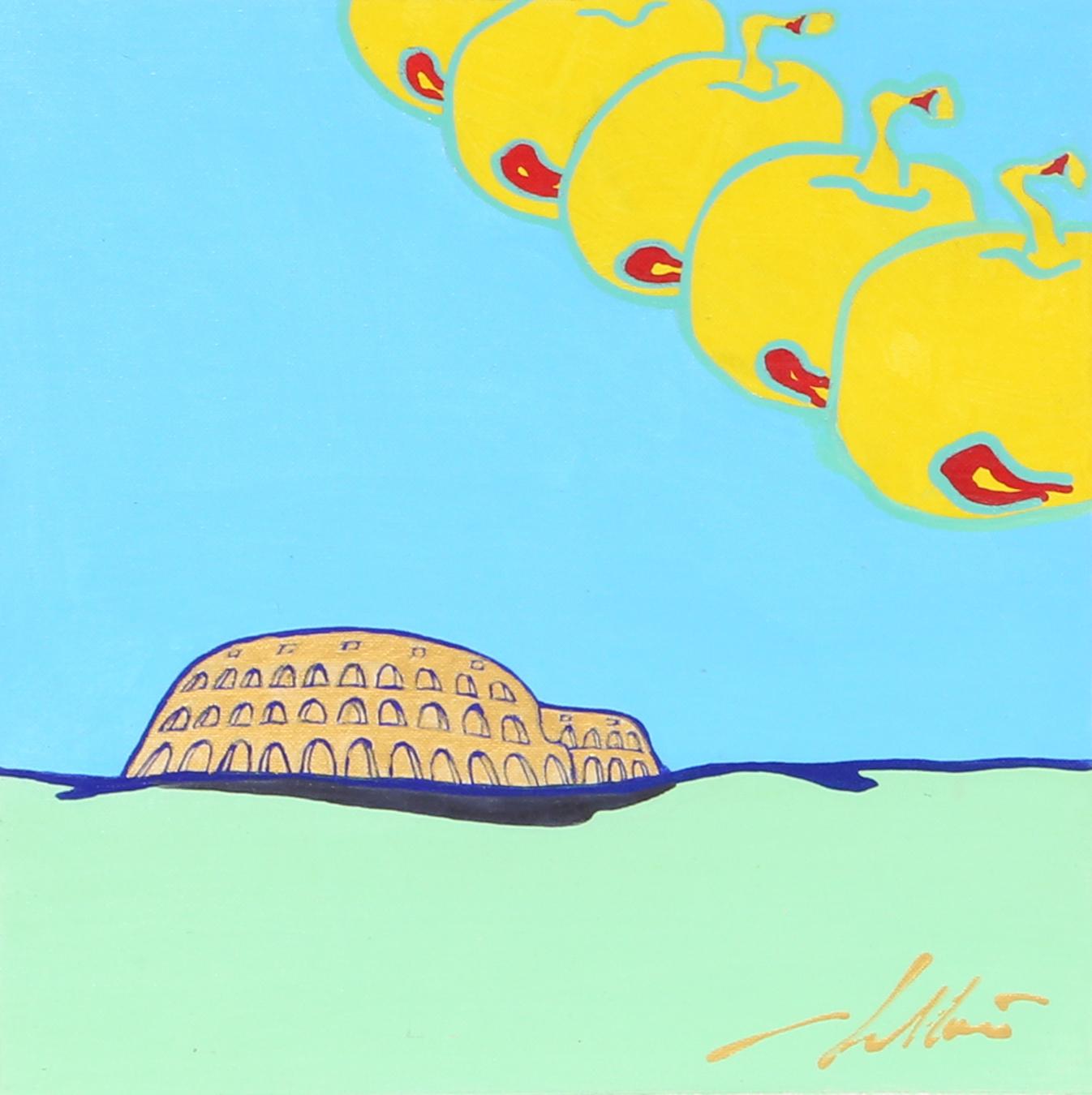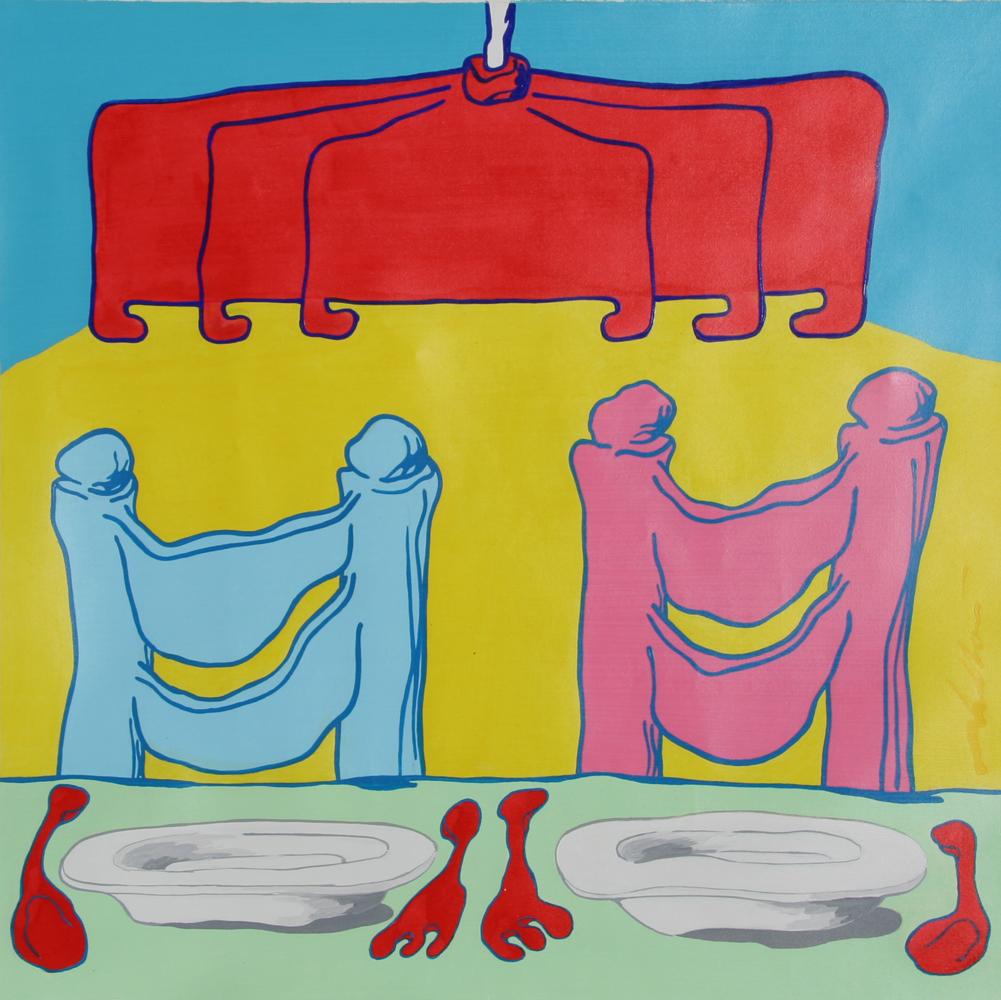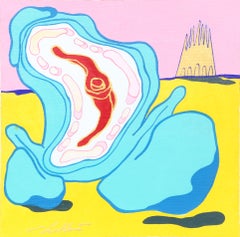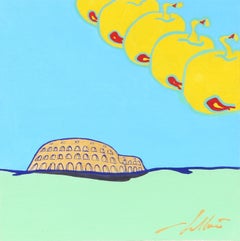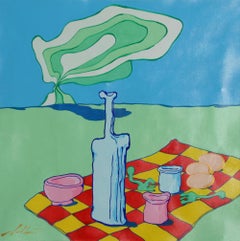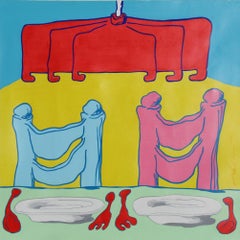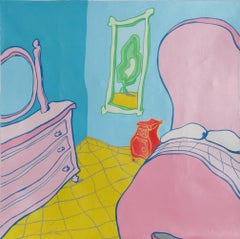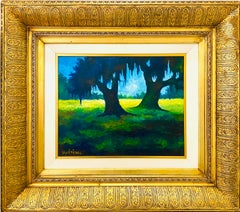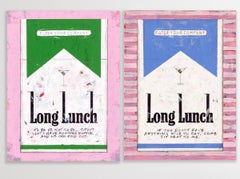Pietro Bulloni Paintings
to
1
13
3
10
11
2
8
3
1
1
Overall Height
to
Overall Width
to
12
1
7
4
2
2
1
1
1
1
1
1
13
14
899
676
665
610
12
12
12
12
1
Artist: Pietro Bulloni
Vista Mare con Cornice, Psychedelic Enamel on Canvas Painting by Pietro Bulloni
By Pietro Bulloni
Located in Long Island City, NY
Artist: Pietro Bulloni, Italian (1947 - )
Title: Vista Mare con Cornice
Year: 2012
Medium: Enamel on Canvas, signed, titled and dated
Size: 51 x 23.75 in. (129.54 x 60.33 cm)
Frame: ...
Category
2010s Pop Art Pietro Bulloni Paintings
Materials
Enamel
Il Tempo Corre (e Milano), Pop Surrealist Painting by Pietro Bulloni
By Pietro Bulloni
Located in Long Island City, NY
Artist: Pietro Bulloni, Italian (1947 - )
Title: Il Tempo Corre (e Milano)
Year: 2015
Medium: Oil on Canvas, signed, dated, and titled verso
Size: 12 x 12 in. (30.48 x 30.48 cm)
Category
2010s Pop Art Pietro Bulloni Paintings
Materials
Oil, Canvas
Frutti del Tempo (Roma), Pop Surrealist Painting by Pietro Bulloni
By Pietro Bulloni
Located in Long Island City, NY
Artist: Pietro Bulloni, Italian (1947 - )
Title: Frutti del Tempo (Roma)
Year: 2015
Medium: Oil on Canvas, signed, dated, and titled verso
Size: 12 x 12 in. (30.48 x 30.48 cm)
Category
2010s Pop Art Pietro Bulloni Paintings
Materials
Oil, Canvas
Picnic, Pop Surrealist Painting by Pietro Bulloni
By Pietro Bulloni
Located in Long Island City, NY
Artist: Pietro Bulloni, Italian (1947 - )
Title: Picnic
Year: 2010
Medium: Oil on Canvas, signed, dated, and titled verso
Size: 23.5 in. x 23.5 in. (59.69 cm x 59.69 cm)
Category
2010s Pop Art Pietro Bulloni Paintings
Materials
Oil, Canvas
La Tavola, Pop Surrealist Painting by Pietro Bulloni
By Pietro Bulloni
Located in Long Island City, NY
Artist: Pietro Bulloni, Italian (1947 - )
Title: La Tavola
Year: 2010
Medium: Oil on Canvas, signed, dated, and titled verso
Size: 23.5 in. x 23.5 in. (59.69...
Category
2010s Pop Art Pietro Bulloni Paintings
Materials
Canvas, Oil
Interal Letto, Pop Surrealist Painting by Pietro Bulloni
By Pietro Bulloni
Located in Long Island City, NY
Artist: Pietro Bulloni, Italian (1947 - )
Title: Interal Letto
Year: 2010
Medium: Oil on Canvas, signed, dated, and titled verso
Size: 23.5 in. x 23.5 in. (59.69 cm x 59.69 cm)
Category
2010s Pop Art Pietro Bulloni Paintings
Materials
Oil, Canvas
Lo Ete (a Firenze), Pop Surrealist Painting by Pietro Bulloni
By Pietro Bulloni
Located in Long Island City, NY
Artist: Pietro Bulloni, Italian (1947 - )
Title: Lo Ete (a Firenze)
Year: 2015
Medium: Oil on Canvas, signed, dated, and titled verso
Size: 12 x 12 in. (30.48 x 30.48 cm)
Category
2010s Pop Art Pietro Bulloni Paintings
Materials
Oil, Canvas
Liamo Alla Frutta, Pop Surrealist Painting by Pietro Bulloni
By Pietro Bulloni
Located in Long Island City, NY
Artist: Pietro Bulloni, Italian (1947 - )
Title: Liamo Alla Frutta
Year: 2015
Medium: Oil on Canvas, signed, dated, and titled verso
Size: 12 x 12 in. (30.48 x 30.48 cm)
Category
2010s Pop Art Pietro Bulloni Paintings
Materials
Oil, Canvas
Naturalmente (Roma), Pop Surrealist Painting by Pietro Bulloni
By Pietro Bulloni
Located in Long Island City, NY
Artist: Pietro Bulloni, Italian (1947 - )
Title: Naturalmente (Roma)
Year: 2015
Medium: Oil on Canvas, signed, dated, and titled verso
Size: 12 x 12 in. (30.48 x 30.48 cm)
Category
2010s Pop Art Pietro Bulloni Paintings
Materials
Oil, Canvas
Programma Preferito (Roma), Oil Painting on Canvas by Pietro Bulloni
By Pietro Bulloni
Located in Long Island City, NY
Artist: Pietro Bulloni, Italian (1947 - )
Title: Programma Preferito (Roma)
Year: 2015
Medium: Oil on Canvas, signed, dated, and titled verso
Image Size: 12 x 12 inches
Size: 15.5 x ...
Category
2010s Pop Art Pietro Bulloni Paintings
Materials
Canvas, Oil
Libri, Oil Painting on Canvas by Pietro Bulloni
By Pietro Bulloni
Located in Long Island City, NY
Artist: Pietro Bulloni, Italian (1947 - )
Title: Libri
Year: 2018
Medium: Oil on Canvas, signed, dated, and titled verso
Image Size: 12 x 12 inches
Size: 15.5 x 15.5 in. (39.37 x 39....
Category
2010s Pop Art Pietro Bulloni Paintings
Materials
Canvas, Oil
Unaici e Quarantahue (Clock on Three Books), Painting by Pietro Bulloni
By Pietro Bulloni
Located in Long Island City, NY
Artist: Pietro Bulloni
Title: Unaici e Quarantahue (Clock on Three Books)
Year: 2003
Medium: Oil on Canvas, signed ll
Size: 12 x 10 inches
Frame Size: 17 x 15 inches
Category
Early 2000s Surrealist Pietro Bulloni Paintings
Materials
Oil
Desiderio, Painting by Pietro Bulloni
By Pietro Bulloni
Located in Long Island City, NY
Artist: Pietro Bulloni, Italian (1947- )
Title: Desiderio
Year: 2007
Medium: Oil over Lithograph on Canvas, signed, dated and titled verso
Canvas Size: 27.5 x 27.5 inches
Frame...
Category
Early 2000s Pop Art Pietro Bulloni Paintings
Materials
Canvas, Oil, Lithograph
Related Items
Louisiana Landscape with Two Oak Trees
By George Rodrigue
Located in Metairie, LA
The Oak Tree defined Rodrigue’s early and beloved works, and this piece represented a return to his roots to create a stunning work in the color palate of the artist’s iconic Blue Do...
Category
21st Century and Contemporary Pop Art Pietro Bulloni Paintings
Materials
Acrylic, Oil, Canvas
Diptych of Long Lunch Sit Next to Me BLUE ON PINK & Shakespeare's Long Lunch
Located in Deddington, GB
“TO BE OR NOT TO BE… TIPSY. LET’S HAVE ANOTHER BOTTLE AND WE CAN FIND OUT"
Original painting in mixed media by William Richard Hylton. This painting features a quote inspired by Wil...
Category
2010s Pop Art Pietro Bulloni Paintings
Materials
Canvas, Mixed Media, Oil
H 40.01 in W 60.08 in D 1.38 in
Flowers 1978, Op Art Floral Oil Tempera on Board Roses Pop Art Large Painting
By Lowell Nesbitt
Located in Surfside, FL
Lowell Nesbitt
(American, 1933-1993)
Flower, 1978
tempera on board
60 1/2 x 40 1/2 inches.
Provenance:
Sold: Christie's East, May 18, 1999, Lot 224
Blair Nesbitt is an American painter, draughtsman, printmaker, and sculptor. Although he worked in a variety of media and covered a wide range of subjects throughout his career, he is best known for his large, Photorealist botanical paintings.
Born in Baltimore, Maryland in 1933, Nesbitt earned a degree from the Tyler School of Art at Temple University. Later, he also studied at London’s Royal Academy of Arts.
Working in stained glass and etching and also producing abstract paintings in his early career, a 1962 encounter with artist Robert Indiana led him to steer his aesthetic toward realism. Though he held his first solo show at the Baltimore Museum of Art in 1958, it was his 1964 debut at the Corcoran Gallery of Art in Washington D.C. that would truly bring him to the attention of the art world. In this exhibit, his botanical series of paintings, drawings, and prints captivated the art world and public alike. The game-changing Corcoran Gallery show would send his career down the trajectory of sustained success.
In 1976, Nesbitt moved from his New York City West 14th Street studio to a massive space located at 389 West 12th Street. The 12,500 square foot living and workspace supplied ample room for creating his enormous paintings...
Category
1970s Pop Art Pietro Bulloni Paintings
Materials
Canvas, Oil
Large Modernist Oil Painting Card Poker Player Aaron Fink Pop Art Americana
By Aaron Fink
Located in Surfside, FL
Aaron Fink (American, b. 1955)
Hand signed and dated 1986, verso.
The large canvas size measures approx: 72" x 66". This painting is part of the artist's "Images of Gambling" series, amongst his best figural work.
Aaron Fink was born in Boston in 1955. He received his MFA from Yale University and his BFA from the Maryland Institute College of Art. His work has been exhibited widely throughout the U.S., Europe and Japan and Australia, and is included in the collections of the Museum of Modern Art, NY, the Art Institute of Chicago, the Museum of Fine Arts, Boston and the Walker Art Center, Minneapolis, among many others. He lives and works in the Boston area. He has been the subject of solo exhibitions at the Massachusetts Institute of Technology, the Muskegon Museum of Art, Michigan, the Rockford Art Museum, Illinois, and Colorado State University, Fort Collins. Figurative abstract expressionist art.
In 2002 a monograph on Fink’s work, Out of the Ordinary, was published, with text by Eleanor Heartney. In 1983 Fink met the collector John Powers, who remained a strong supporter of his work until his death in 1999. Fink’s work is represented in the collections of the Art Institute of Chicago, the Hara Museum, Tokyo, the Metropolitan Museum of Art, New York, the Museum of Modern Art, New York and the National Gallery of Art, Washington, DC, among many others. Fink currently divides his time between Boston and Rockport, Massachusetts.
He was included in the show The Expressive Voice: Selections from the Permanent Collection at the Danforth Museum of Art. An exhibition of Boston Expressionism, a school that embraced a distinctive blend of visionary painting, dark humor, religious mysticism, and social commentary. Historical roots of this movement can be traced to European Symbolism and German Expressionism, but artists living and working in the Boston area from the 1930’s through the 1950’s, were particularly inspired by Chaim Soutine and Max Beckmann. Artists included; Aaron Fink,
Bernard Chaet, David Aronson, Ernst Ludwig Kirchner, Hyman Bloom, Jack Levine, Jackson Pollock, Jason Berger, Karl Zerbe, Lawrence Kupferman, Michael Mazur, Sigmund Abeles and Willem de Kooning.
He was included in the show 40 Years of Printmaking: From the Center Street Studio Archives, along other great figural artists Gabor Peterdi, John Walker, Lester Johnson and Nell Blaine.
S E L E C T E D C O L L E C T I O N S
Art Institute of Chicago
Bank of America
Boston Public Library
Bouwfonds Nederlandse Gemeenten, The Netherlands
Brooklyn Museum of Art
Castelli Collection, New York
Chase Manhattan Bank
Chemical Bank
Choate Rosemary Hall, Wallingford, CT
Citizens Bank, Boston
Coopers & Lybrand
Danforth Museum, Framingham, MA
Danish House of Parliament
Davis Museum, Wellesley College, Wellesley, MA
DeCordova Museum and Sculpture Park Lincoln, MA
Farnsworth Museum, Maine
Fidelity Investments, Boston
Fogg Museum of Art, Harvard University, Cambridge, MA
Fuller Museum of Art, Brockton, MA
G.E. Corporation
Goldman Sachs & Company
IBM, New York
Indianapolis Museum of Art
Library of Congress
Massachusetts Institute of Technology, Cambridge, MA
Metropolitan Museum of Art, New York
Museum of Contemporary Art, Chicago
Museum of Fine Arts, Boston
Museum of Modern Art, New York
National Gallery of Art, Washington, DC
New York Public Library
Philadelphia Museum of Art
Portland Museum of Art, Portland, Maine
United States Department of State
University of Massachusetts, Amherst
Awards
Residency, Anderson Ranch, Snowmass, CO, 1998, 1996
National Endowment for the Arts, 1987, 1982
Artist Fellowship, Massachusetts Council on the Arts and Humanities, 1984
American Academy in Rome, Prix de Rome – Alternate in Painting, 1979
Yale University, Ford Foundation Special Project Grant, Fall 1979
Skowhegan Scholarship Award, conferred by the Maryland Institute College of Art, Spring 1976
SELECTED GROUP EXHIBITIONS
Contemporary Responses to Modernism: A New England Perspective, University of Southern Maine
Color and Line: Expressive Tradition in Boston, Endicott College, Beverly, MA,
Beautiful Decay, Danforth Art Museum, Framingham, MA
MICA Then and Now, Ethan Cohen Gallery, Beacon, NY
Bon Appetit, Concord Art Association
Celebrating Ten Years, Galerie D’Avignon, Montreal, Canada
New England Impressions: Exploring the Woodcut, Concord Art, Concord, MA
Go Figure: The Figure in Contemporary Art – A Response to Art History,
Painting in Boston: 1950-2000, DeCordova Museum and Sculpture Park, Lincoln, MA
Working Sources: The Painter and the Photographic Image, Alpha Gallery, Boston, MA
The Unique Print: Six Innovative Approaches to the Monotype, Starr Gallery, Newton, MA
Selections from Atelier Mourlot, Hankyu Department Store, Tokyo, Japan
Yale Collects Yale, Yale University Art Gallery, New Haven, CT, 1993
70’s and 80’s: Printmaking Now, Museum of Fine Arts, Boston, MA, 1986-1987
Skowhegan Alumni, Leo Castelli Gallery, New York, and Portland Museum of Art, Portland, Maine,
Public and Private: American Prints Today, Brooklyn Museum, Brooklyn, NY
Contemporary Miami Collectors, Metropolitan Museum, Coral Gables, FL, 1984
The American Artist as Printmaker, Brooklyn Museum, Brooklyn, NY, 1983-84
Jon Abbott, Aaron Fink, Tom Lieber, Chris Wool...
Category
1980s Pop Art Pietro Bulloni Paintings
Materials
Canvas, Oil
The Race
Located in Deddington, GB
The Race by Stephanie Ho [2018]
original
Oil Paint on Canvas
Image size: H:100 cm x W:100 cm
Complete Size of Unframed Work: H:100 cm x W:100 cm x D:4cm
Sold Unframed
Please note th...
Category
21st Century and Contemporary Pop Art Pietro Bulloni Paintings
Materials
Canvas, Oil
De-Extinctionizer (Lyuba) by BARC the dog, comic book style, woolly mammoth
Located in Jersey City, NJ
De-Extinctionizer (Lyuba) by BARC the dog (2022), pop art comic book style, acrylic on canvas, illustration, cartoon inspired character art, laboratory scene, ...
Category
2010s Pop Art Pietro Bulloni Paintings
Materials
Acrylic, Canvas
H 36 in W 24 in D 1.5 in
Glittering Autumn, Nicky Chubb, Original Tree Painting, Bright Contemporary Art
By Nicky Chubb
Located in Deddington, GB
Glittering Autumn by Nicky Chubb [2022]
Signed by the artist
Acrylic on Canvas
Image size: H:100 cm x W:100 cm x D:4cm
Please note that insitu images are purely an indication of how ...
Category
21st Century and Contemporary Pop Art Pietro Bulloni Paintings
Materials
Canvas, Resin, Acrylic
H 39.38 in W 39.38 in D 1.58 in
"Elvis", Denied Andy Warhol Silver & Black Pop Art Painting by Charles Lutz
By Charles Lutz
Located in Brooklyn, NY
Elvis, Metallic Silver and Black Full Length Silkscreen Painting by Charles Lutz
Silkscreen and silver enamel painted on vintage 1960's era linen with Artist's Denied stamp of the Andy Warhol Art Authentication Board.
82" x 40" inches
2010
Lutz's 2007 ''Warhol Denied'' series gained international attention by calling into question the importance of originality or lack thereof in the work of Andy Warhol. The authentication/denial process of the [[Andy Warhol Art Authentication Board]] was used to create value by submitting recreations of Warhol works for judgment with the full intention for the works to be formally marked "DENIED". The final product of the conceptual project being "officially denied" "Warhol" paintings authored by Lutz.
Based on the full-length Elvis Presley paintings by Pop Artist Andy Warhol in 1964, this is likely one of his most iconic images, next to Campbell's Soup Cans and portraits of Jackie Kennedy, Marilyn Monroe, Liz Taylor, and Marlon Brando. This is the rarest of the Elvis works from the series, as Lutz sourced a vintage roll of 1960's primed artist linen which was used for this one Elvis. The silkscreen, like Warhol's embraced imperfections, like the slight double image printing of the Elvis image.
Lutz received his BFA in Painting and Art History from Pratt Institute and studied Human Dissection and Anatomy at Columbia University, New York. Lutz's work deals with perceptions and value structures, specifically the idea of the transference of values. Lutz's most recently presented an installation of new sculptures dealing with consumerism at Frank Lloyd Wright's Fallingwater House in 2022.
Lutz's 2007 Warhol Denied series received international attention calling into question the importance of originality in a work of art. The valuation process (authentication or denial) of the Andy Warhol Art Authentication Board was used by the artist to create value by submitting recreations of Warhol works for judgment, with the full intention for the works to be formally marked "DENIED" of their authenticity. The final product of this conceptual project is "Officially DENIED" "Warhol" paintings authored by Lutz.
Later in 2013, Lutz went on to do one of his largest public installations to date. At the 100th Anniversary of Marcel Duchamp's groundbreaking and controversial Armory Show, Lutz was asked by the curator of Armory Focus: USA and former Director of The Andy Warhol Museum, Eric Shiner to create a site-specific installation representing the US. The installation "Babel" (based on Pieter Bruegel's famous painting) consisted of 1500 cardboard replicas of Warhol's Brillo Box (Stockholm Type) stacked 20 ft tall. All 1500 boxes were then given to the public freely, debasing the Brillo Box as an art commodity by removing its value, in addition to debasing its willing consumers.
Elvis was "the greatest cultural force in the Twentieth Century. He introduced the beat to everything, and he changed everything - music, language, clothes, it's a whole new social revolution." Leonard Bernstein in: Exh. Cat., Boston, The Institute of Contemporary Art and traveling, Elvis + Marilyn 2 x Immortal, 1994-97, p. 9.
Andy Warhol "quite simply changed how we all see the world around us." Kynaston McShine in: Exh. Cat., New York, Museum of Modern Art (and traveling), Andy Warhol: Retrospective, 1996, p. 13.
In the summer of 1963 Elvis Presley was just twenty-eight years old but already a legend of his time. During the preceding seven years - since Heartbreak Hotel became the biggest-selling record of 1956 - he had recorded seventeen number-one singles and seven number-one albums; starred in eleven films, countless national TV appearances, tours, and live performances; earned tens of millions of dollars; and was instantly recognized across the globe. The undisputed King of Rock and Roll, Elvis was the biggest star alive: a cultural phenomenon of mythic proportions apparently no longer confined to the man alone. As the eminent composer Leonard Bernstein put it, Elvis was "the greatest cultural force in the Twentieth Century. He introduced the beat to everything, and he changed everything - music, language, clothes, it's a whole new social revolution." (Exh. Cat., Boston, The Institute of Contemporary Art (and traveling), Elvis + Marilyn 2 x Immortal, 1994, p. 9).
In the summer of 1963 Andy Warhol was thirty-four years old and transforming the parameters of visual culture in America. The focus of his signature silkscreen was leveled at subjects he brilliantly perceived as the most important concerns of day to day contemporary life. By appropriating the visual vernacular of consumer culture and multiplying readymade images gleaned from newspapers, magazines and advertising, he turned a mirror onto the contradictions behind quotidian existence. Above all else he was obsessed with themes of celebrity and death, executing intensely multifaceted and complex works in series that continue to resound with universal relevance. His unprecedented practice re-presented how society viewed itself, simultaneously reinforcing and radically undermining the collective psychology of popular culture. He epitomized the tide of change that swept through the 1960s and, as Kynaston McShine has concisely stated, "He quite simply changed how we all see the world around us." (Exh. Cat., New York, Museum of Modern Art (and traveling), Andy Warhol: Retrospective, 1996, p. 13).
Thus in the summer of 1963 there could not have been a more perfect alignment of artist and subject than Warhol and Elvis. Perhaps the most famous depiction of the biggest superstar by the original superstar artist, Double Elvis is a historic paradigm of Pop Art from a breath-taking moment in Art History. With devastating immediacy and efficiency, Warhol's canvas seduces our view with a stunning aesthetic and confronts our experience with a sophisticated array of thematic content. Not only is there all of Elvis, man and legend, but we are also presented with the specter of death, staring at us down the barrel of a gun; and the lone cowboy, confronting the great frontier and the American dream. The spray painted silver screen denotes the glamour and glory of cinema, the artificiality of fantasy, and the idea of a mirror that reveals our own reality back to us. At the same time, Warhol's replication of Elvis' image as a double stands as metaphor for the means and effects of mass-media and its inherent potential to manipulate and condition. These thematic strata function in simultaneous concert to deliver a work of phenomenal conceptual brilliance. The portrait of a man, the portrait of a country, and the portrait of a time, Double Elvis is an indisputable icon for our age.
The source image was a publicity still for the movie Flaming Star, starring Presley as the character Pacer Burton and directed by Don Siegel in 1960. The film was originally intended as a vehicle for Marlon Brando and produced by David Weisbart, who had made James Dean's Rebel Without a Cause in 1955. It was the first of two Twentieth Century Fox productions Presley was contracted to by his manager Colonel Tom Parker, determined to make the singer a movie star. For the compulsive movie-fan Warhol, the sheer power of Elvis wielding a revolver as the reluctant gunslinger presented the zenith of subject matter: ultimate celebrity invested with the ultimate power to issue death. Warhol's Elvis is physically larger than life and wears the expression that catapulted him into a million hearts: inexplicably and all at once fearful and resolute; vulnerable and predatory; innocent and explicit. It is the look of David Halberstam's observation that "Elvis Presley was an American original, the rebel as mother's boy, alternately sweet and sullen, ready on demand to be either respectable or rebellious." (Exh. Cat., Boston, Op. Cit.). Indeed, amidst Warhol's art there is only one other subject whose character so ethereally defies categorization and who so acutely conflated total fame with the inevitability of mortality. In Warhol's work, only Elvis and Marilyn harness a pictorial magnetism of mythic proportions.
With Marilyn Monroe, whom Warhol depicted immediately after her premature death in August 1962, he discovered a memento mori to unite the obsessions driving his career: glamour, beauty, fame, and death. As a star of the silver screen and the definitive international sex symbol, Marilyn epitomized the unattainable essence of superstardom that Warhol craved. Just as there was no question in 1963, there remains still none today that the male equivalent to Marilyn is Elvis. However, despite his famous 1968 adage, "If you want to know all about Andy Warhol, just look at the surface of my paintings" Warhol's fascination held purpose far beyond mere idolization. As Rainer Crone explained in 1970, Warhol was interested in movie stars above all else because they were "people who could justifiably be seen as the nearest thing to representatives of mass culture." (Rainer Crone, Andy Warhol, New York, 1970, p. 22). Warhol was singularly drawn to the idols of Elvis and Marilyn, as he was to Marlon Brando and Liz Taylor, because he implicitly understood the concurrence between the projection of their image and the projection of their brand. Some years after the present work he wrote, "In the early days of film, fans used to idolize a whole star - they would take one star and love everything about that star...So you should always have a product that's not just 'you.' An actress should count up her plays and movies and a model should count up her photographs and a writer should count up his words and an artist should count up his pictures so you always know exactly what you're worth, and you don't get stuck thinking your product is you and your fame, and your aura." (Andy Warhol, The Philosophy of Andy Warhol (From A to B and Back Again), San Diego, New York and London, 1977, p. 86).
The film stars of the late 1950s and early 1960s that most obsessed Warhol embodied tectonic shifts in wider cultural and societal values. In 1971 John Coplans argued that Warhol was transfixed by the subject of Elvis, and to a lesser degree by Marlon Brando and James Dean, because they were "authentically creative, and not merely products of Hollywood's fantasy or commercialism. All three had originative lives, and therefore are strong personalities; all three raised - at one level or another - important questions as to the quality of life in America and the nature of its freedoms. Implicit in their attitude is a condemnation of society and its ways; they project an image of the necessity for the individual to search for his own future, not passively, but aggressively, with commitment and passion." (John Coplans, "Andy Warhol and Elvis Presley," Studio International, vol. 181, no. 930, February 1971, pp. 51-52). However, while Warhol unquestionably adored these idols as transformative heralds, the suggestion that his paintings of Elvis are uncritical of a generated public image issued for mass consumption fails to appreciate the acuity of his specific re-presentation of the King.
As with Marilyn, Liz and Marlon, Warhol instinctively understood the Elvis brand as an industrialized construct, designed for mass consumption like a Coca-Cola bottle or Campbell's Soup Can, and radically revealed it as a precisely composed non-reality. Of course Elvis offered Warhol the biggest brand of all, and he accentuates this by choosing a manifestly contrived version of Elvis-the-film-star, rather than the raw genius of Elvis as performing Rock n' Roll pioneer. A few months prior to the present work he had silkscreened Elvis' brooding visage in a small cycle of works based on a simple headshot, including Red Elvis, but the absence of context in these works minimizes the critical potency that is so present in Double Elvis. With Double Elvis we are confronted by a figure so familiar to us, yet playing a role relating to violence and death that is entirely at odds with the associations entrenched with the singer's renowned love songs. Although we may think this version of Elvis makes sense, it is the overwhelming power of the totemic cipher of the Elvis legend that means we might not even question why he is pointing a gun rather than a guitar. Thus Warhol interrogates the limits of the popular visual vernacular, posing vital questions of collective perception and cognition in contemporary society.
The notion that this self-determinedly iconic painting shows an artificial paradigm is compounded by Warhol's enlistment of a reflective metallic surface, a treatment he reserved for his most important portraits of Elvis, Marilyn, Marlon and Liz. Here the synthetic chemical silver paint becomes allegory for the manufacture of the Elvis product, and directly anticipates the artist's 1968 statement: "Everything is sort of artificial. I don't know where the artificial stops and the real starts. The artificial fascinates me, the bright and shiny..." (Artist quoted in Exh. Cat., Stockholm, Moderna Museet and traveling, Andy Warhol, 1968, n.p.). At the same time, the shiny silver paint of Double Elvis unquestionably denotes the glamour of the silver screen and the attractive fantasies of cinema. At exactly this time in the summer of 1963 Warhol bought his first movie camera and produced his first films such as Sleep, Kiss and Tarzan and Jane Regained. Although the absence of plot or narrative convention in these movies was a purposely anti-Hollywood gesture, the unattainability of classic movie stardom still held profound allure and resonance for Warhol. He remained a celebrity and film fanatic, and it was exactly this addiction that so qualifies his sensational critique of the industry machinations behind the stars he adored.
Double Elvis was executed less than eighteen months after he had created 32 Campbell's Soup Cans for his immortal show at the Ferus Gallery, Los Angeles in July and August 1962, and which is famously housed in the Museum of Modern Art, New York. In the intervening period he had produced the series Dollar Bills, Coca-Cola Bottles, Suicides, Disasters, and Silver Electric Chairs, all in addition to the portrait cycles of Marilyn and Liz. This explosive outpouring of astonishing artistic invention stands as definitive testament to Warhol's aptitude to seize the most potent images of his time. He recognized that not only the product itself, but also the means of consumption - in this case society's abandoned deification of Elvis - was symptomatic of a new mode of existence. As Heiner Bastian has precisely summated: "the aura of utterly affirmative idolization already stands as a stereotype of a 'consumer-goods style' expression of an American way of life and of the mass-media culture of a nation." (Exh. Cat., Berlin, Neue Nationalgalerie (and traveling), Andy Warhol: Retrospective, 2001, p. 28).
For Warhol, the act of image replication and multiplication anaesthetized the effect of the subject, and while he had undermined the potency of wealth in 200 One Dollar Bills, and cheated the terror of death by electric chair in Silver Disaster # 6, the proliferation of Elvis here emasculates a prefabricated version of character authenticity. Here the cinematic quality of variety within unity is apparent in the degrees to which Presley's arm and gun become less visible to the left of the canvas. The sense of movement is further enhanced by a sense of receding depth as the viewer is presented with the ghost like repetition of the figure in the left of the canvas, a 'jump effect' in the screening process that would be replicated in the multiple Elvis paintings. The seriality of the image heightens the sense of a moving image, displayed for us like the unwinding of a reel of film.
Elvis was central to Warhol's legendary solo exhibition organized by Irving Blum at the Ferus Gallery in the Fall of 1963 - the show having been conceived around the Elvis paintings since at least May of that year. A well-known installation photograph shows the present work prominently presented among the constant reel of canvases, designed to fill the space as a filmic diorama. While the Elvis canvases...
Category
21st Century and Contemporary Pop Art Pietro Bulloni Paintings
Materials
Enamel
Churchill's RED Long Lunch, Original painting, Pop art, Cigarettes
Located in Deddington, GB
“SUCCESS IS NOT FINAL, FAILURE IS NOT FATAL. IT IS THE COURAGE TO CONTINUE THAT COUNTS… SO YES WE WILL HAVE ANOTHER BOTTLE“
Original painting in mixed media by William Richard Hylt...
Category
2010s Pop Art Pietro Bulloni Paintings
Materials
Canvas, Mixed Media, Oil
H 40.01 in W 30.04 in D 1.38 in
Churchill and Pollock's Long Lunch, Original Painting, Pop art, Cigrarettes
Located in Deddington, GB
Success is not final, failure is not fatal. It is the courage to continue that counts… So yes we will have another bottle.
ADDITIONAL INFORMATION:
Original painting
Mixed Media on ...
Category
2010s Pop Art Pietro Bulloni Paintings
Materials
Canvas, Mixed Media, Oil
H 40.01 in W 30.04 in D 1.38 in
CAMPBELLS CHICKEN NOODLE SOUP
By Steve Kaufman
Located in Aventura, FL
Hand embellished with oil paint on silkscreen canvas. Hand signed and numbered by the artist on verso. TP edition of 50. Canvas is stretched.
Artwork is in excellent condition. C...
Category
21st Century and Contemporary Pop Art Pietro Bulloni Paintings
Materials
Canvas, Oil, Screen
New York Way of Life
Located in Atlanta, GA
Silvia Martínez Jiménez was born in 1975 in Gandia, a province in Valencia, Spain. When she was young, she was attracted to the works of classic Valencian painters and the Valencia ...
Category
2010s Pop Art Pietro Bulloni Paintings
Materials
Canvas, Mixed Media, Acrylic
Pietro Bulloni paintings for sale on 1stDibs.
Find a wide variety of authentic Pietro Bulloni paintings available for sale on 1stDibs. If you’re browsing the collection of paintings to introduce a pop of color in a neutral corner of your living room or bedroom, you can find work that includes elements of blue, green and other colors. You can also browse by medium to find art by Pietro Bulloni in canvas, fabric, oil paint and more. Much of the original work by this artist or collective was created during the 21st century and contemporary and is mostly associated with the Pop Art style. Not every interior allows for large Pietro Bulloni paintings, so small editions measuring 12 inches across are available. Customers who are interested in this artist might also find the work of Lori Larusso , Michael Giliberti, and Chris Pegg. Pietro Bulloni paintings prices can differ depending upon medium, time period and other attributes. On 1stDibs, the price for these items starts at $1,200 and tops out at $8,500, while the average work can sell for $1,500.
